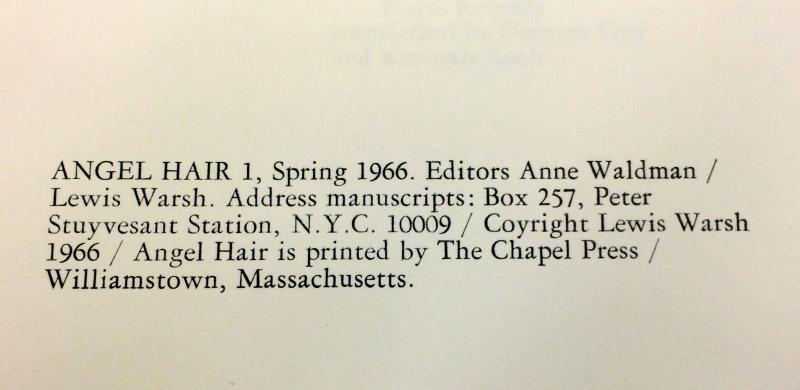The Fales Library Angel Hair archive

It feels both hugely restorative and humbling, in our age of digital media, to visit an archive and hold a fifty year-old literary magazine, carefully made and preserved, yet still fleetingly physical, in your hand. Anne Waldman, co-editor (with Lewish Warsh) of the small magazine Angel Hair, describes the significance of that experience in this quote from her introductory essay to the 2002 Angel Hair feature in Jacket: “...so-called ephemera, lovingly and painstakingly produced, have tremendous power. They signify meticulous human attention and intelligence, like the outline of a hand in a Cro-Magnon cave.” This “tremendous power” can be applied specifically to Angel Hair, which published the work of Ted Berrigan, Denise Levertov, Joe Brainard, Michael Brownstein, and Warsh and Waldman themselves, among others, early in their lives as poets.
The journal, which ran for three years and six issues (1966-1969) before Warsh and Waldman turned to printing books for friends, many of whom had first appeared in the pages of Angel Hair, has a simple but elegant design, with the title alone printed on “elegant Fabriano cover paper” and large (9 x 12) pages allowing for “ample space around the works” (Waldman). The image to the left shows the Table of Contents for Issue 1 of Angel Hair, beginning with a Kenneth Koch translation of Pierre Reverdy. Warsh and Waldman met, as Warsh says in his introductory essay for Jacket, “in the earliest stages of our becoming poets,” at Robert Duncan's reading at the seminal 1965 Berkeley Poetry Conference, where many poets featured in Donald Allen's 1960 The New American Poetry anthology gathered to participate. Waldman recalls that “I will always forever after think we founded Angel Hair within that auspicious moment.”
 Warsh, who originally felt more aligned with the Black Mountain poets and the San Francisco poets than with the New York School, later came to realize “that all the geographical/aesthetic divisions which Don Allen used to structure his anthology were open to question...and this insight...had a lot to do with my later stance as an editor.” Angel Hair and its readers benefited greatly from this geographically open stance. Anne Waldman, reflecting on the magazine's brief but influential history, said that “the magazine was a project of friendships, artistic collaboration, which are defining qualities of ‘New York School.’ Yet our project mixed up East and West Coast scenes and juxtaposed them in an unusual and appealing context....In retrospect, Angel Hair seems a seed syllable that unlocked various energetic post-modern and post-New American poetry possibilities, giving a younger generation cognizance that you can take your work, literally, into your own hands.” This DIY spirit infuses the poetry scene to this day, with our current abundance of journals and presses, many of which encourage the mixing and mingling of various scenes and styles of poetry. We can look to Angel Hair, along with some of its contemporaries, like 0 to 9 or Ted Berrigan's C, as the crucial precursors of the contemporary experimental poetry scene.
Warsh, who originally felt more aligned with the Black Mountain poets and the San Francisco poets than with the New York School, later came to realize “that all the geographical/aesthetic divisions which Don Allen used to structure his anthology were open to question...and this insight...had a lot to do with my later stance as an editor.” Angel Hair and its readers benefited greatly from this geographically open stance. Anne Waldman, reflecting on the magazine's brief but influential history, said that “the magazine was a project of friendships, artistic collaboration, which are defining qualities of ‘New York School.’ Yet our project mixed up East and West Coast scenes and juxtaposed them in an unusual and appealing context....In retrospect, Angel Hair seems a seed syllable that unlocked various energetic post-modern and post-New American poetry possibilities, giving a younger generation cognizance that you can take your work, literally, into your own hands.” This DIY spirit infuses the poetry scene to this day, with our current abundance of journals and presses, many of which encourage the mixing and mingling of various scenes and styles of poetry. We can look to Angel Hair, along with some of its contemporaries, like 0 to 9 or Ted Berrigan's C, as the crucial precursors of the contemporary experimental poetry scene.
Reports from the archives